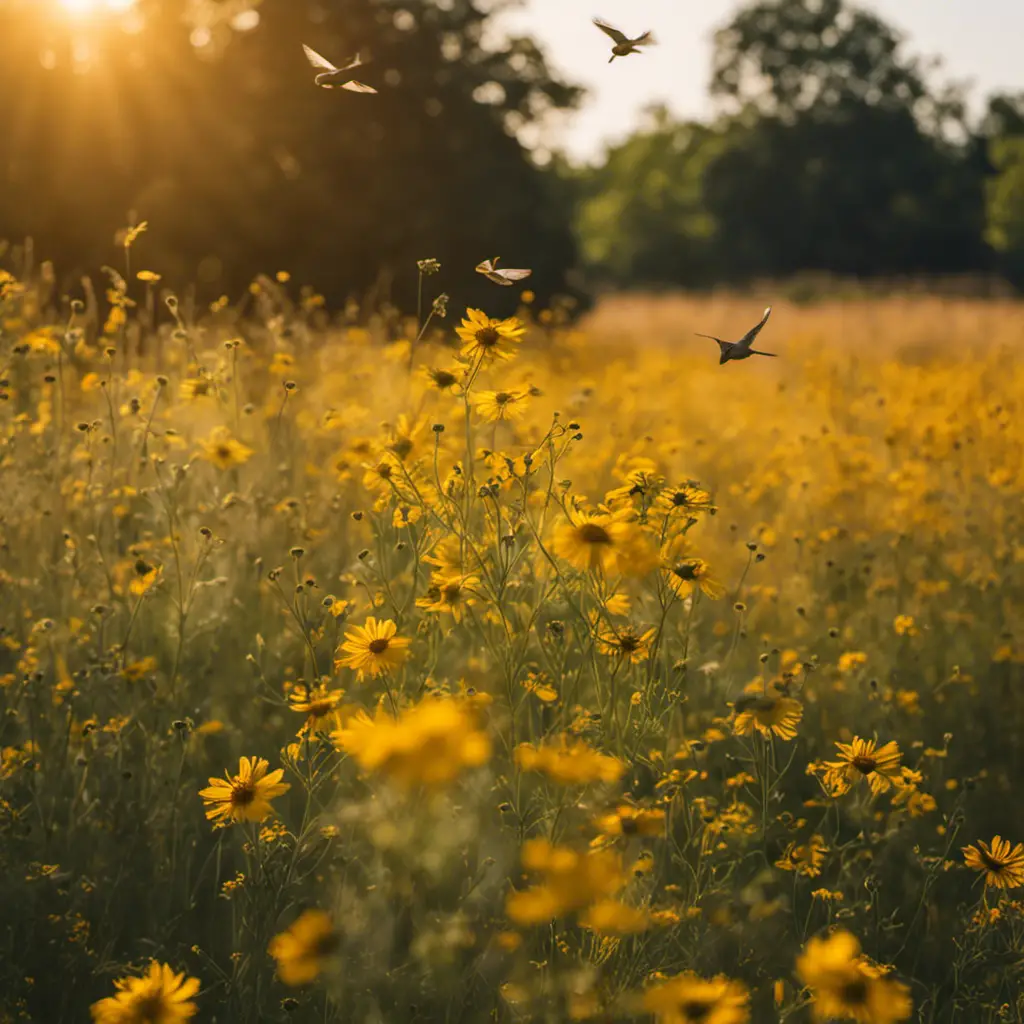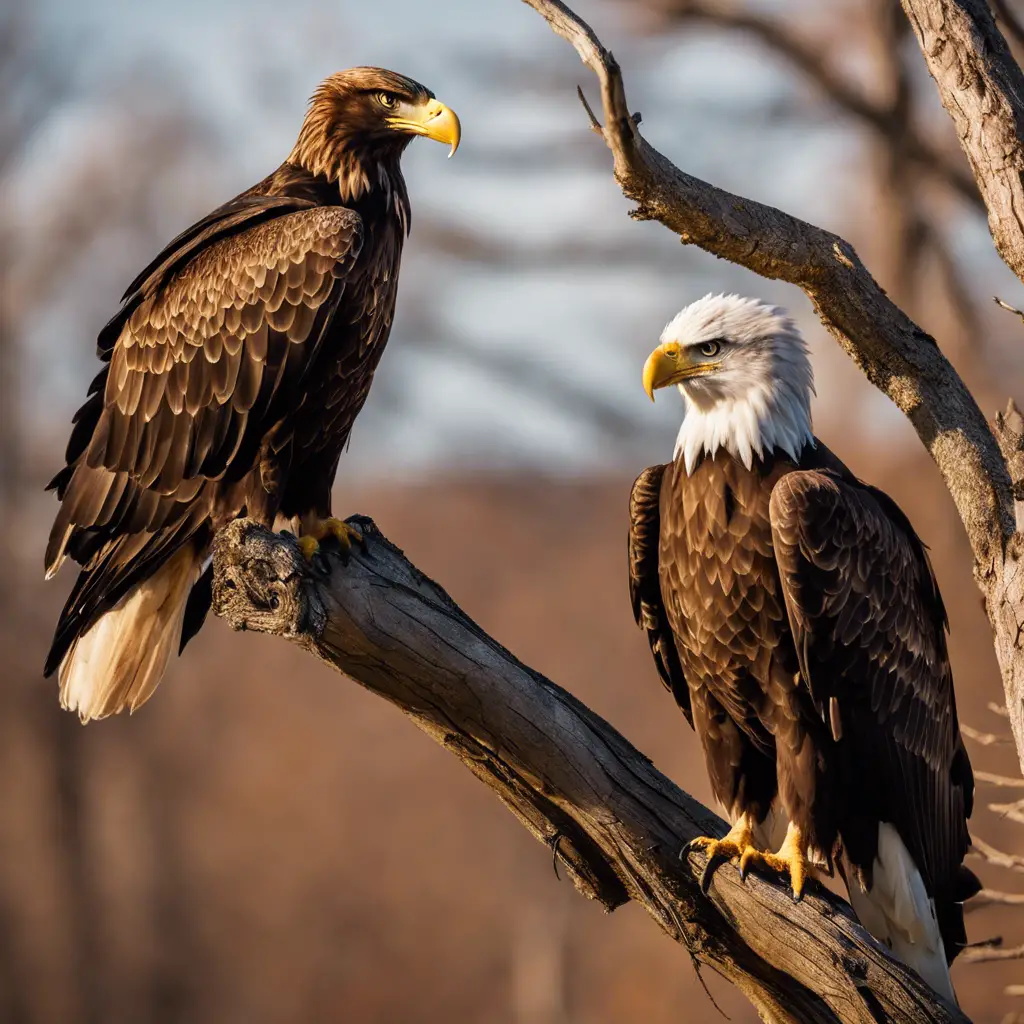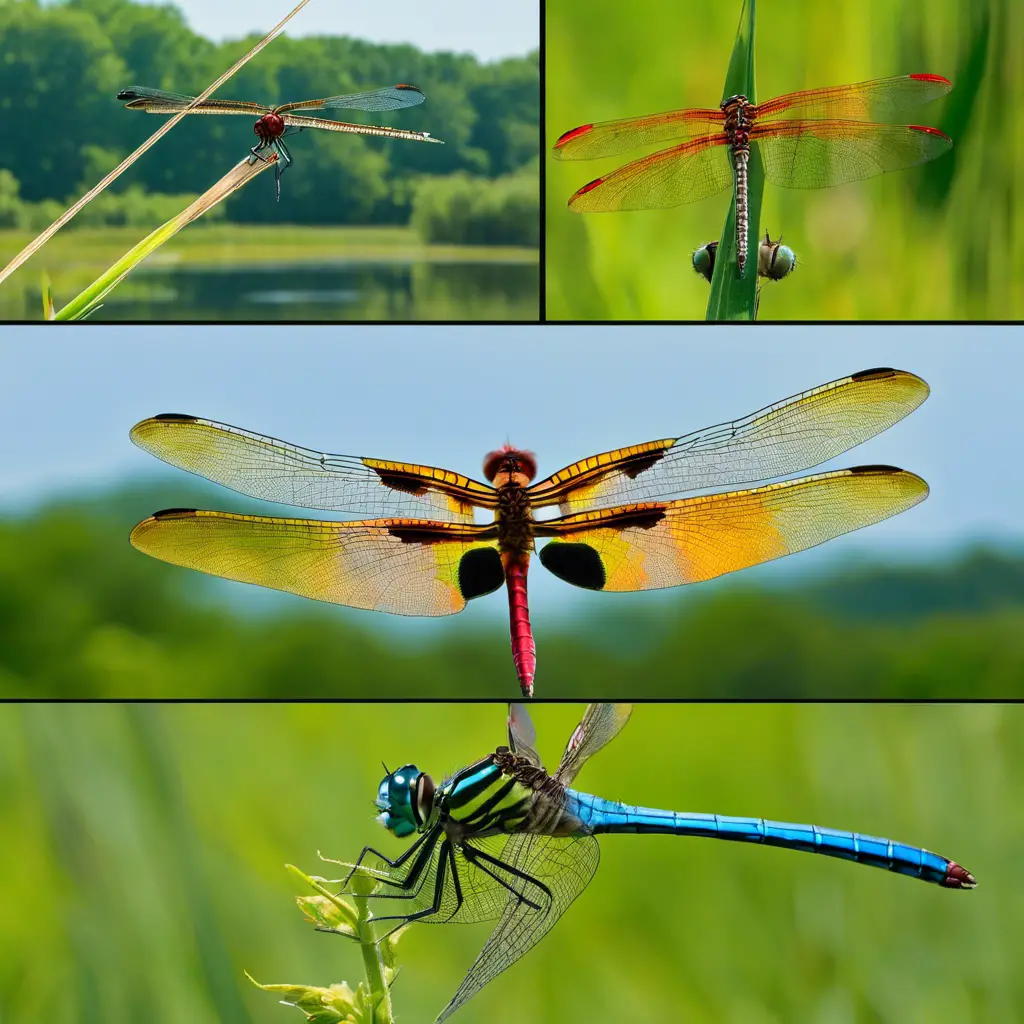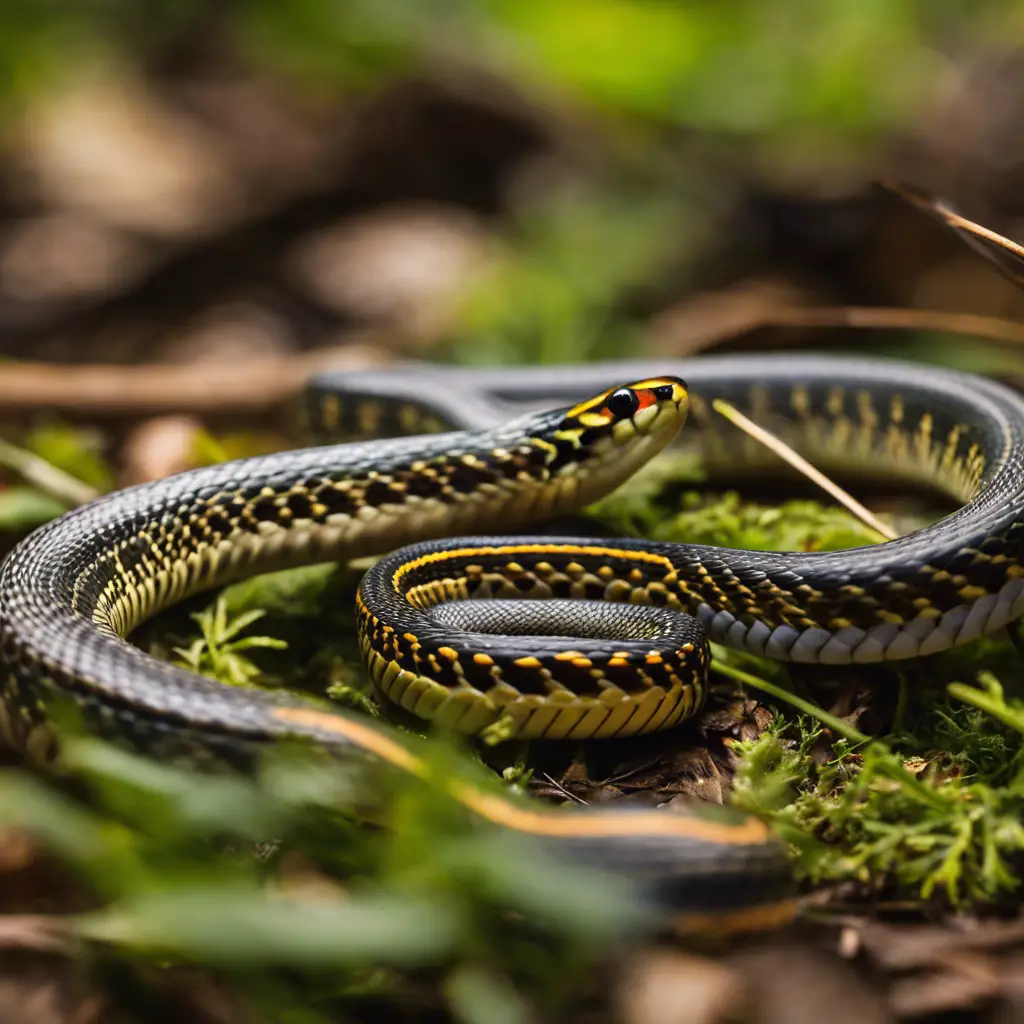Are you curious about the vibrant yellow birds that can be found in Ohio? Look no further!
In this article, you’ll discover a variety of yellow-feathered species that call Ohio their home. From the delightful American Goldfinch and the melodious Yellow Warbler to the elusive Hooded Warbler and the striking Yellow-headed Blackbird, Ohio offers a haven for these beautiful creatures.
Get ready to explore the diverse avian population and learn fascinating facts about the yellow birds that grace the skies of Ohio.
Key Takeaways
- American Goldfinch is a common sight in Ohio and is known for its distinctive color and beautiful song.
- Yellow Warbler, Common Yellowthroat, Hooded Warbler, Kentucky Warbler, and Prothonotary Warbler are migratory songbirds that breed and winter in Ohio.
- Yellow-breasted Chat, Yellow-throated Warbler, Pine Warbler, Prairie Warbler, and Worm-eating Warbler have specific preferred habitats and nesting behaviors in Ohio.
- Northern Parula, Yellow-rumped Warbler, Blackburnian Warbler, Black-throated Green Warbler, and Black-and-white Warbler have their preferred habitats and nesting behaviors in Ohio, along with distinctive plumage and characteristics.
American Goldfinch

You should look out for American Goldfinches during your birdwatching trips in Ohio. These vibrant yellow birds are a common sight in the state, known for their distinctive color and beautiful song.
The behavior and habitat of American Goldfinches are fascinating to observe. They prefer open areas with scattered trees and shrubs, such as meadows, fields, and gardens. These birds are highly sociable and often seen in small flocks.
Their diet consists primarily of seeds, with a preference for thistle and sunflower seeds. During nesting season, American Goldfinches build their nests in trees or shrubs using plant fibers and grasses. They’re late nesters compared to other songbirds, waiting for the peak of summer when seed production is at its highest.
Keep an eye out for these delightful birds as they flit and sing throughout Ohio’s natural landscapes.
Yellow Warbler

If you spot a flash of yellow in the trees, it’s likely that a Yellow Warbler is nearby. These small, migratory songbirds are known for their vibrant yellow plumage and melodic songs.
Here are three key points about Yellow Warblers:
Migration Patterns: Yellow Warblers are neotropical migrants, meaning they breed in North America during the summer and then migrate to Central and South America for the winter. They undertake long-distance journeys, with some individuals traveling up to 6,000 miles each way. These birds navigate using a combination of celestial cues and landmarks, such as coastlines and rivers.
Conservation Efforts: Yellow Warblers face various threats, including habitat loss and fragmentation, climate change, and predation by invasive species. Conservation efforts focus on preserving their breeding and wintering habitats, as well as controlling the spread of invasive predators. Additionally, research is being conducted to better understand their migration routes and stopover sites, in order to provide targeted protection and conservation measures.
Common Yellowthroat

Surely, if you look closely, you can spot the Common Yellowthroat hiding among the reeds near the water.
The Common Yellowthroat (Geothlypis trichas) is a small songbird that belongs to the warbler family. Unlike the Yellow Warbler, which is known for its bright yellow plumage and migratory nature, the Common Yellowthroat has a duller olive-green body with a yellow throat, hence its name.
This species is a year-round resident in Ohio, with some individuals migrating to southern states during the winter months.
As for nesting habits, the Common Yellowthroat prefers wetland areas with dense vegetation, such as marshes and swampy regions. The female constructs a cup-shaped nest low to the ground, hidden among the vegetation, where she lays a clutch of 3-5 eggs.
Understanding the yellow warbler migration patterns and the common yellowthroat nesting habits can provide valuable insights into the behavior and conservation of these avian species.
Hooded Warbler
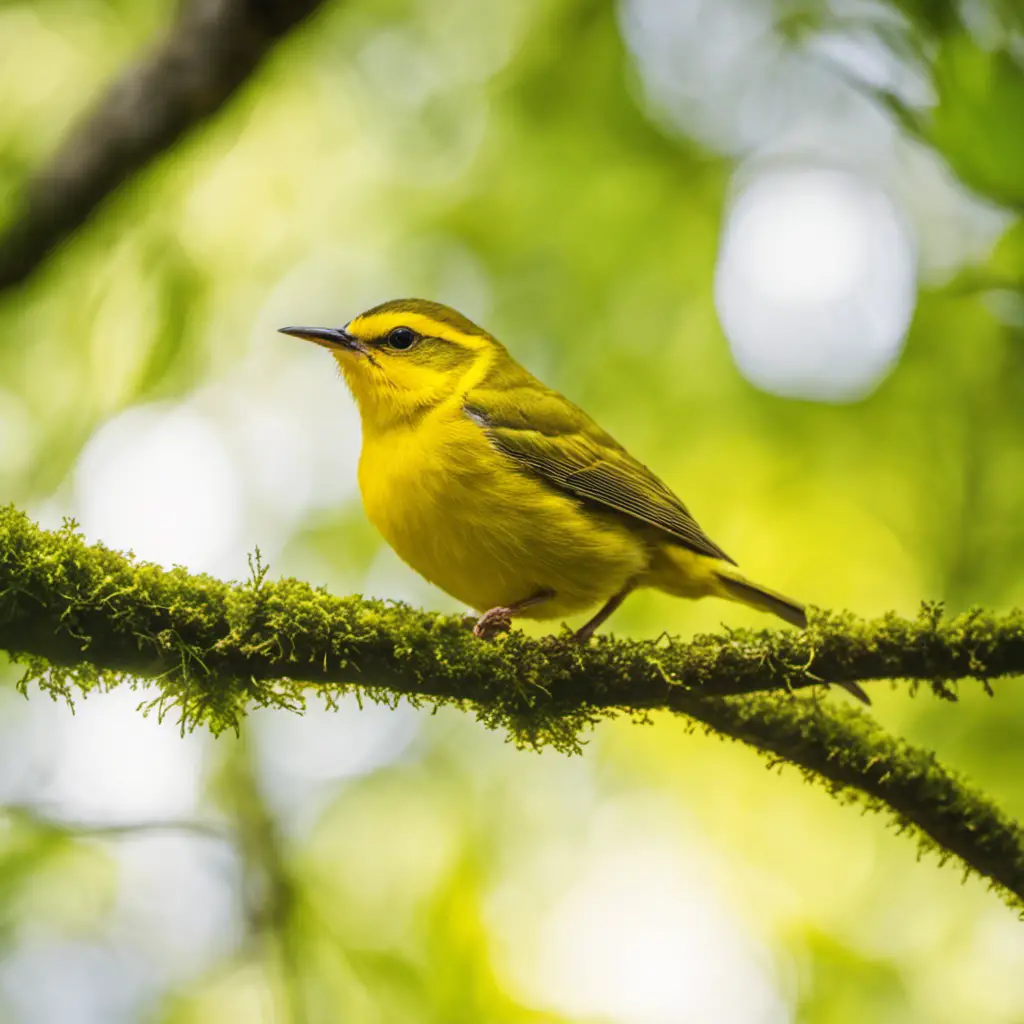
Did you know that the Hooded Warbler is a small songbird that can be found in the eastern United States? This vibrant yellow bird is known for its distinctive black hood and bright yellow underparts.
Here are some key points about the Hooded Warbler’s habitat preferences and breeding behavior:
Habitat preferences:
- The Hooded Warbler is primarily found in deciduous forests with dense undergrowth, preferring areas with a mixture of shrubs and trees.
- They’re most commonly found in the southeastern states, including parts of Ohio, where suitable habitat can be found.
- These birds prefer habitats with moist soil and access to water sources like streams or wetlands.
Breeding behavior:
- Hooded Warblers are neotropical migrants, spending their winters in Central America and the Caribbean before returning to their breeding grounds in the eastern United States.
- Breeding pairs establish territories and create cup-shaped nests low to the ground, typically hidden in dense vegetation.
- Male Hooded Warblers are known for their distinctive, melodious songs that they use to attract mates and defend their territories.
Understanding the habitat preferences and breeding behavior of the Hooded Warbler is crucial for conservation efforts and ensuring the survival of this beautiful species.
Kentucky Warbler
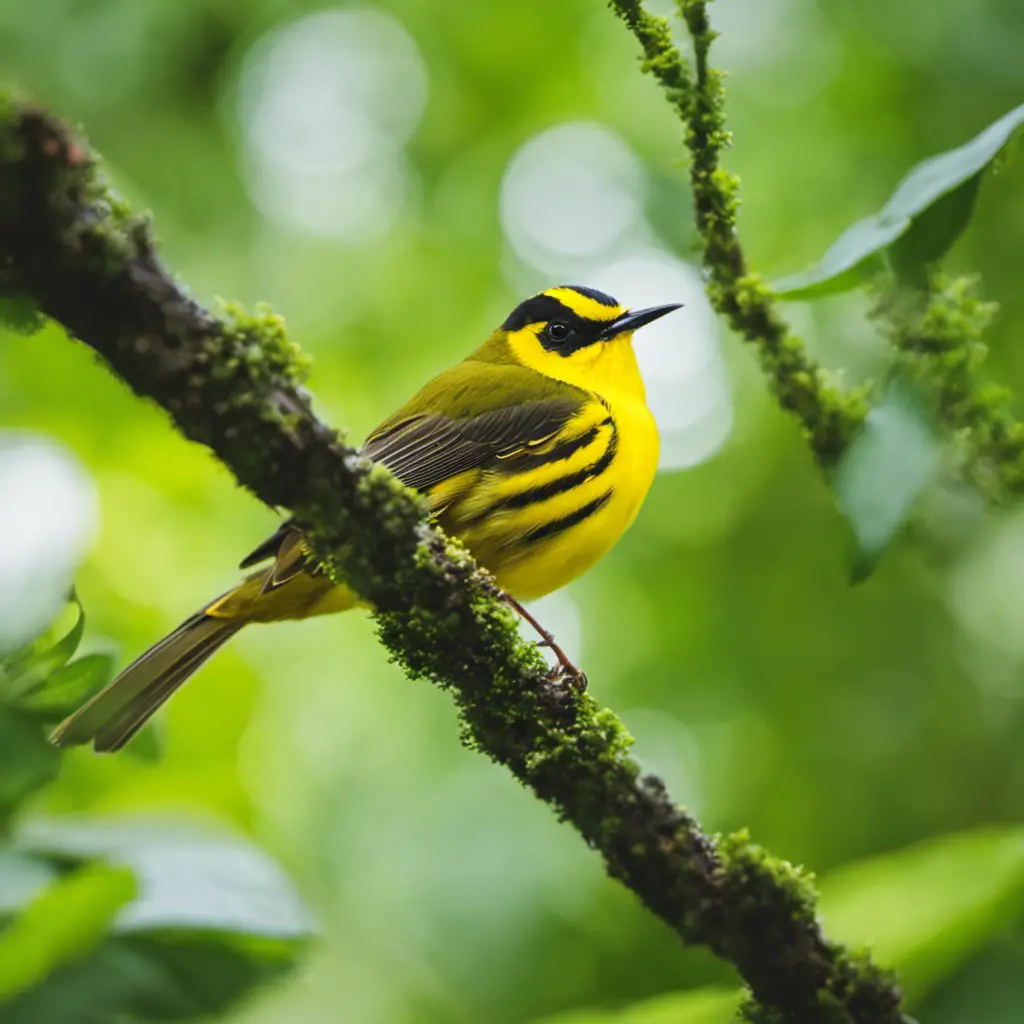
Do you know that the Kentucky Warbler is a rare bird species with only around 1,000 breeding pairs remaining in the United States? This striking yellow bird is primarily found in the eastern and central parts of the country.
The Kentucky Warbler is known for its unique habitat preferences, as it prefers to reside in dense, moist forests with plenty of understory vegetation. These habitats provide the necessary cover and food sources, such as insects and spiders, for this species to thrive.
In terms of behavior, the Kentucky Warbler is a secretive bird that spends most of its time foraging on or near the ground, using its strong bill to search for insects among leaf litter and fallen logs. Its distinctive song, a series of loud, rich notes, can often be heard echoing through the forest during the breeding season.
Understanding the habitat and behavior of the Kentucky Warbler is crucial for conservation efforts aimed at protecting this endangered species.
Prothonotary Warbler

You can easily identify the Prothonotary Warbler by its vibrant yellow plumage and distinctive song. This small songbird is known for its striking appearance and unique vocalizations.
Here are some key points about the Prothonotary Warbler:
Habitat: The Prothonotary Warbler is primarily found in wetland habitats, such as swamps, marshes, and floodplain forests. It prefers areas with standing water and dense vegetation, where it can build its nests in tree cavities or nest boxes.
Migration Patterns: Prothonotary Warblers are neotropical migrants, which means they travel long distances between their breeding grounds in North America and their wintering grounds in Central and South America. They undertake a remarkable journey, crossing the Gulf of Mexico and navigating through various countries to reach their wintering destinations.
Conservation Status: The Prothonotary Warbler is a species of concern due to habitat loss and degradation. Efforts are being made to protect and restore wetland habitats, as well as provide suitable nesting sites, to ensure the survival of this beautiful bird.
Understanding the habitat requirements and migration patterns of the Prothonotary Warbler is crucial for conservation efforts and ensuring the long-term survival of this species.
Yellow-breasted Chat
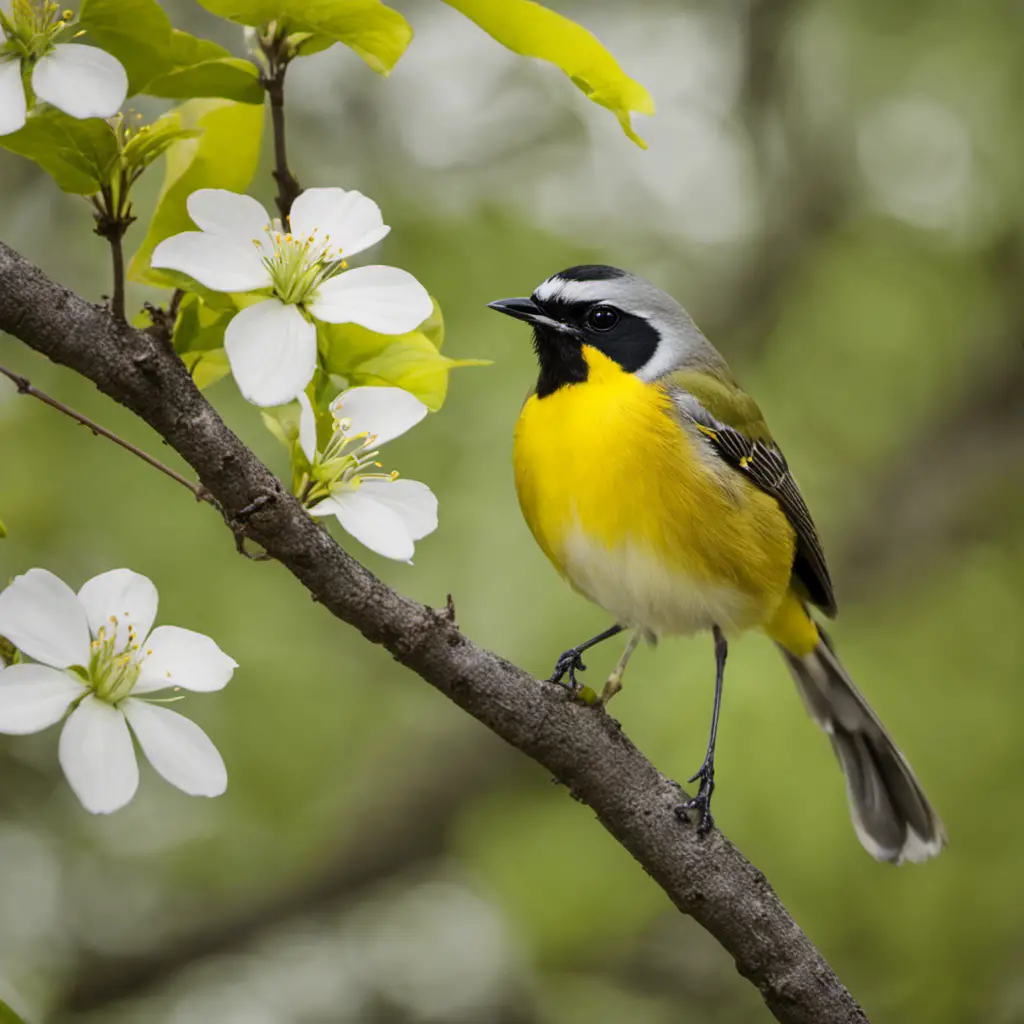
When observing birds in Ohio, be on the lookout for the Yellow-breasted Chat, as it’s known for its vibrant plumage and distinct vocalizations.
The Yellow-breasted Chat, scientifically known as Icteria virens, is a medium-sized songbird that belongs to the family Parulidae. It can be easily identified by its bright yellow breast, olive-green upperparts, and white belly.
This species is primarily found in dense thickets, shrubby areas, and wetlands, where it builds its nests. The Yellow-breasted Chat is known for its unique behavior, which includes a variety of vocalizations such as whistles, trills, and clucks. It’s also known to mimic the songs of other bird species.
During the breeding season, males engage in elaborate courtship displays to attract females.
Overall, the Yellow-breasted Chat is an interesting bird to observe due to its striking appearance and intriguing behaviors.
Yellow-throated Warbler

If you’re interested in yellow birds, you should definitely keep an eye out for the Yellow-throated Warbler, as it’s known for its vibrant plumage and beautiful song. This species, Setophaga dominica, can be found in various parts of North America, including Ohio.
Here are some key points about the Yellow-throated Warbler:
Migration Patterns: Yellow-throated Warblers are neotropical migrants, meaning they travel long distances between breeding and wintering grounds. In Ohio, these birds can be seen during the spring and fall migration seasons as they make their way to and from their breeding grounds in the southeastern United States.
Habitat Preferences: Yellow-throated Warblers prefer mature deciduous forests with tall trees and a dense canopy. They’re commonly found near water sources such as rivers, streams, and swamps. These habitats provide the necessary food resources, nesting sites, and suitable conditions for their survival and reproduction.
Conservation Status: The Yellow-throated Warbler isn’t currently considered a species of concern. However, habitat loss due to deforestation and urbanization poses a potential threat to their populations. Conservation efforts focused on preserving and restoring their preferred habitats can help ensure the continued presence of these beautiful birds in Ohio and beyond.
Pine Warbler

Keep an eye out for the Pine Warbler, as it’s a small songbird that can be easily identified by its yellow plumage and distinct trilling call.
The Pine Warbler, scientifically known as Setophaga pinus, is a species commonly found in the eastern parts of North America, including Ohio. These birds are primarily found in coniferous forests, as they prefer habitats with dense pine trees.
While they don’t migrate as far as some other bird species, Pine Warblers do exhibit seasonal movements. During the breeding season, they can be found in the northern parts of their range, including Ohio, and then move southward during the winter months.
Prairie Warbler

You can easily spot the Prairie Warbler by looking for its vibrant yellow plumage and listening to its melodic singing in the open grasslands. This species is primarily found in the eastern United States, including Ohio, where it inhabits a variety of habitats such as shrubby fields, grasslands, and young forests.
The Prairie Warbler is known for its unique migration patterns, which differ from other warblers. Here are three key points about the Prairie Warbler’s migration:
Neotropical Migrant: The Prairie Warbler is a neotropical migrant, which means it travels long distances between its breeding grounds in North America and its wintering grounds in the Caribbean and Central America.
Timing: This species typically arrives in its breeding grounds in late April to early May and departs for its wintering grounds in September.
Migratory Behavior: During migration, Prairie Warblers can be seen in a variety of habitats, including coastal areas, forests, and even urban parks, as they make their way to their wintering grounds.
Understanding the Prairie Warbler’s habitat and migration patterns is essential for conservation efforts and ensuring the species’ survival.
Worm-eating Warbler
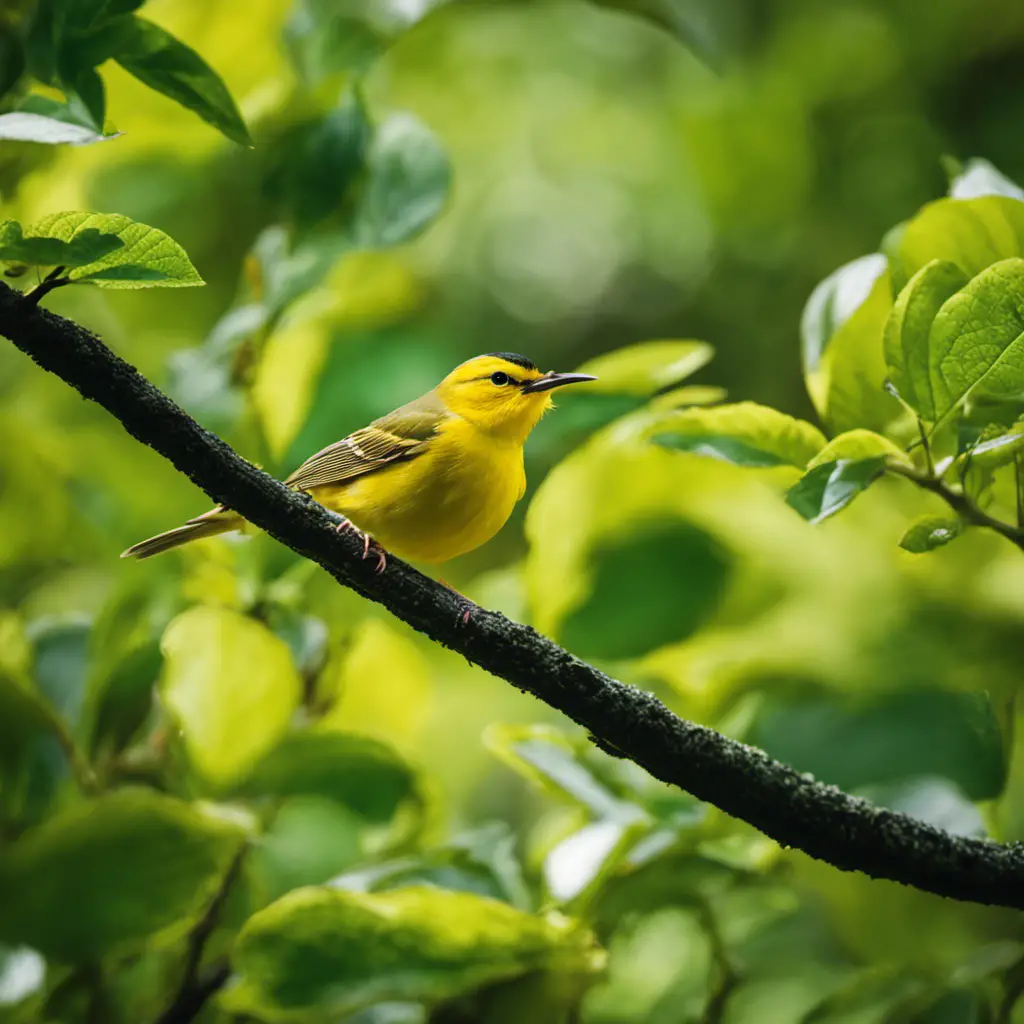
You’ll be fascinated to learn that the Worm-eating Warbler is a ground-dwelling bird that forages for insects and worms in the leaf litter of forests. This species, scientifically known as Helmitheros vermivorus, is primarily found in the eastern United States during the breeding season.
The Worm-eating Warbler has a unique breeding behavior, as it constructs its nest on the ground, usually in dense vegetation or leaf litter. Conservation efforts have been put in place to protect the breeding habitats of this species, as loss of suitable habitat and nest predation pose threats to its population. These efforts include the preservation and restoration of forests, as well as the creation of protected areas.
Additionally, research is being conducted to better understand the Worm-eating Warbler’s breeding habits and develop effective conservation strategies.
Northern Parula

Don’t miss the chance to spot a Northern Parula, a small songbird that frequents Ohio during migration season. These vibrant yellow birds are a delight to observe and can be found in various habitats such as forests, woodlands, and even urban areas.
Here are three key points to understand about the Northern Parula:
Northern parula migration: These birds undertake long-distance migrations, traveling from their breeding grounds in the southern United States, Mexico, and the Caribbean to their wintering grounds in Central and South America. They pass through Ohio during their spring and fall migrations, making it a prime time to spot them.
Northern parula nesting behavior: These birds build intricate, cup-shaped nests in trees. They typically choose trees that have moss or lichens growing on their branches, as this provides camouflage for their nests. The female lays a clutch of 3-5 eggs, which she incubates for about 12 days until they hatch.
With their striking colors and unique nesting behaviors, the Northern Parula is a fascinating bird to observe during its migration through Ohio. Keep your eyes and ears open for their distinctive song and you may be lucky enough to catch a glimpse of these beautiful birds in action.
Yellow-rumped Warbler

Spotting a Yellow-rumped Warbler can be a thrilling experience, as these small songbirds showcase vibrant yellow patches on their rumps. These warblers are known for their fascinating migration patterns and nesting habits.
During the breeding season, Yellow-rumped Warblers can be found in coniferous forests across North America, including Ohio. They build cup-shaped nests made of twigs and grasses, typically placed high up in trees. These nests provide a safe haven for the female to lay her eggs and raise her young.
As the seasons change, Yellow-rumped Warblers embark on impressive migrations. In the fall, they travel south to warmer regions, such as Central and South America. During these long journeys, they rely on their strong flight abilities and their keen sense of direction.
Understanding the migration patterns and nesting habits of Yellow-rumped Warblers is crucial for conservation efforts and preserving their populations.
Blackburnian Warbler
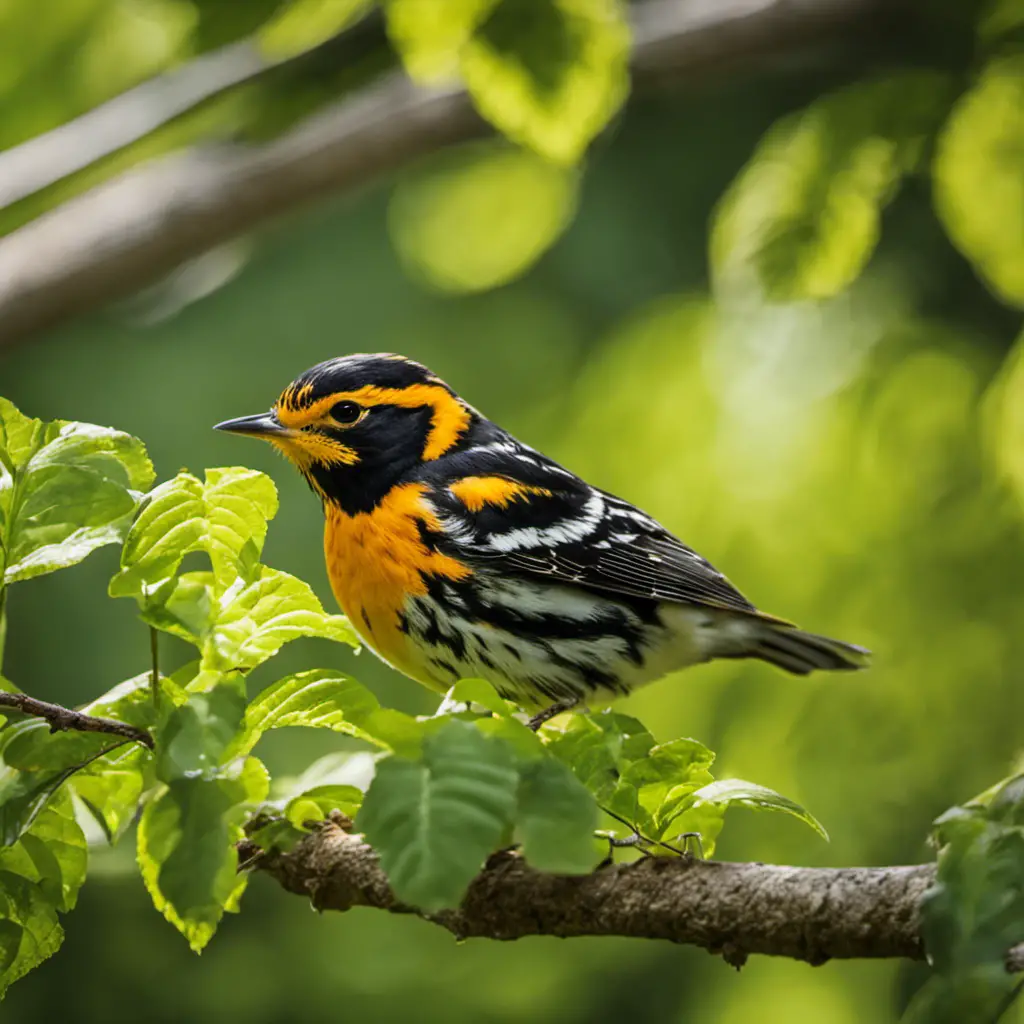
There are several other species of warblers in Ohio, but if you’re lucky, you might spot a Blackburnian Warbler during its spring migration. These beautiful birds are known for their vibrant orange throat and black and white striped feathers.
Here are some fascinating facts about the Blackburnian Warbler:
Migration patterns: Blackburnian Warblers are neotropical migrants, which means they travel long distances from their breeding grounds in North America to their wintering grounds in Central and South America. They typically migrate through Ohio in late April to early May, making it a prime time for birdwatchers to catch a glimpse of them.
Nesting habits: Blackburnian Warblers prefer to nest in mature coniferous forests, particularly those with spruce and fir trees. They construct their nests high up in the trees, usually near the end of a branch. The female lays 3-5 eggs, which she incubates for about 12 days. Once the eggs hatch, both parents take turns feeding and caring for the chicks until they fledge.
Black-throated Green Warbler
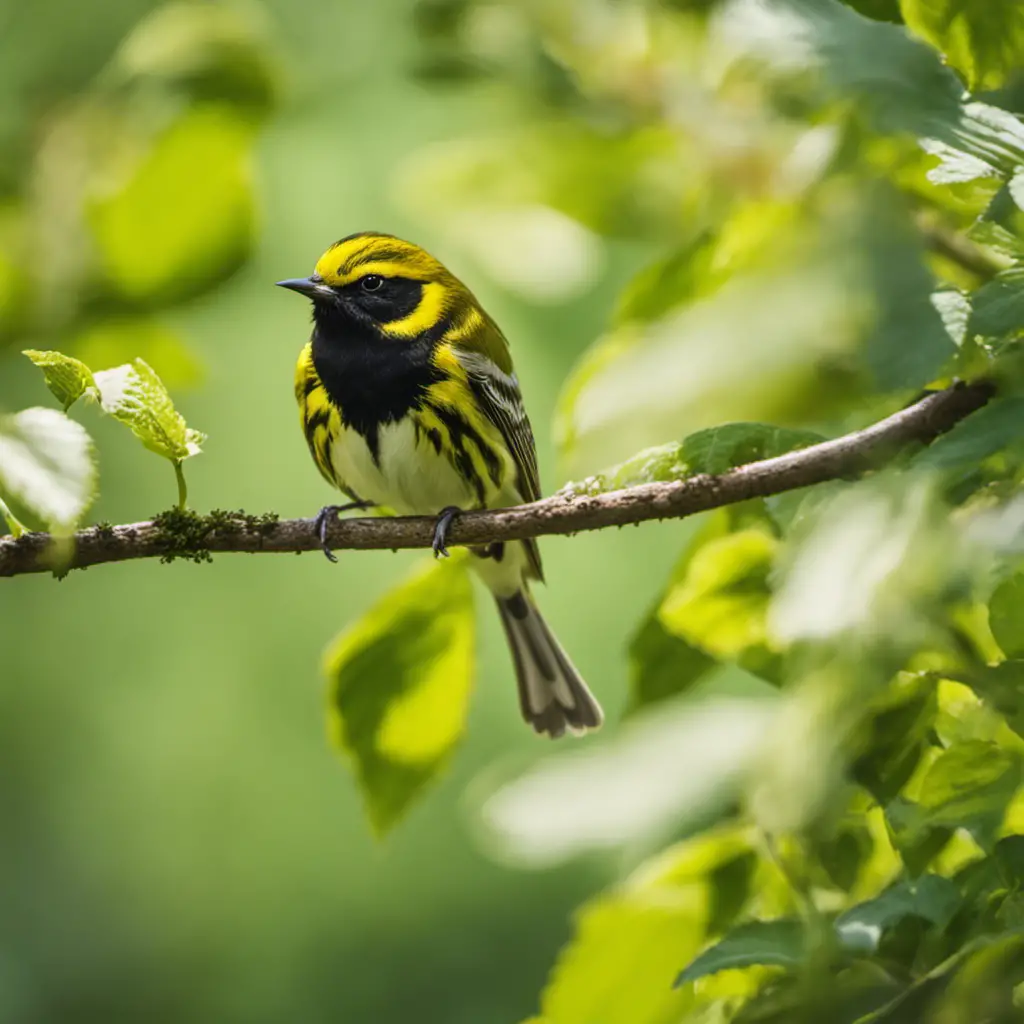
You might be surprised by the striking black throat and vibrant green feathers of the Black-throated Green Warbler as it flits through the trees. This small songbird, scientifically known as Setophaga virens, is a common sight in the eastern parts of North America during the breeding season. However, during the winter months, these warblers undertake a remarkable migration to Central America and the Caribbean, where they find more favorable conditions.
The Black-throated Green Warbler has specific habitat preferences, favoring dense coniferous forests and mixed woodlands with a combination of tall trees and understory vegetation. They are particularly fond of spruce and fir trees, as well as hemlocks and pines. These trees provide them with ample nesting sites and a reliable food source consisting of insects and spiders.
To better understand the migration patterns and habitat preferences of the Black-throated Green Warbler, let’s take a closer look at the information in the table below:
| Migration Patterns | Habitat Preferences |
|---|---|
| Breeds in eastern North America | Dense coniferous forests |
| Migrates to Central America and the Caribbean during winter | Mixed woodlands |
| Relies on spruce, fir, hemlock, and pine trees | Requires understory vegetation |
| Feeds on insects and spiders | Requires tall trees for nesting |
Black-and-white Warbler

Take a moment to observe the unique black-and-white stripes of the Black-and-white Warbler as it moves up and down tree trunks in search of insects. This small songbird, measuring about 5.5 inches in length, is easily recognized by its striking pattern of black and white feathers.
Here are three key features of the Black-and-white Warbler:
Habitat: These birds prefer mature forests with dense understory vegetation. They can be found throughout much of North America during the breeding season and migrate to Central and South America for the winter.
Foraging Behavior: The Black-and-white Warbler has a distinctive foraging style. It uses its sharp beak to probe crevices in tree bark, flicking its wings and tail to maintain balance as it searches for insects.
Vocalization: The male Black-and-white Warbler produces a high-pitched song during the breeding season, consisting of a series of high-pitched notes followed by a trill. This song is used to attract a mate and defend territory.
The Black-and-white Warbler is a fascinating species with its distinctive appearance and foraging behavior. As you observe these birds in their natural habitat, take note of their unique striped pattern and listen for their melodious song.
Chestnut-sided Warbler
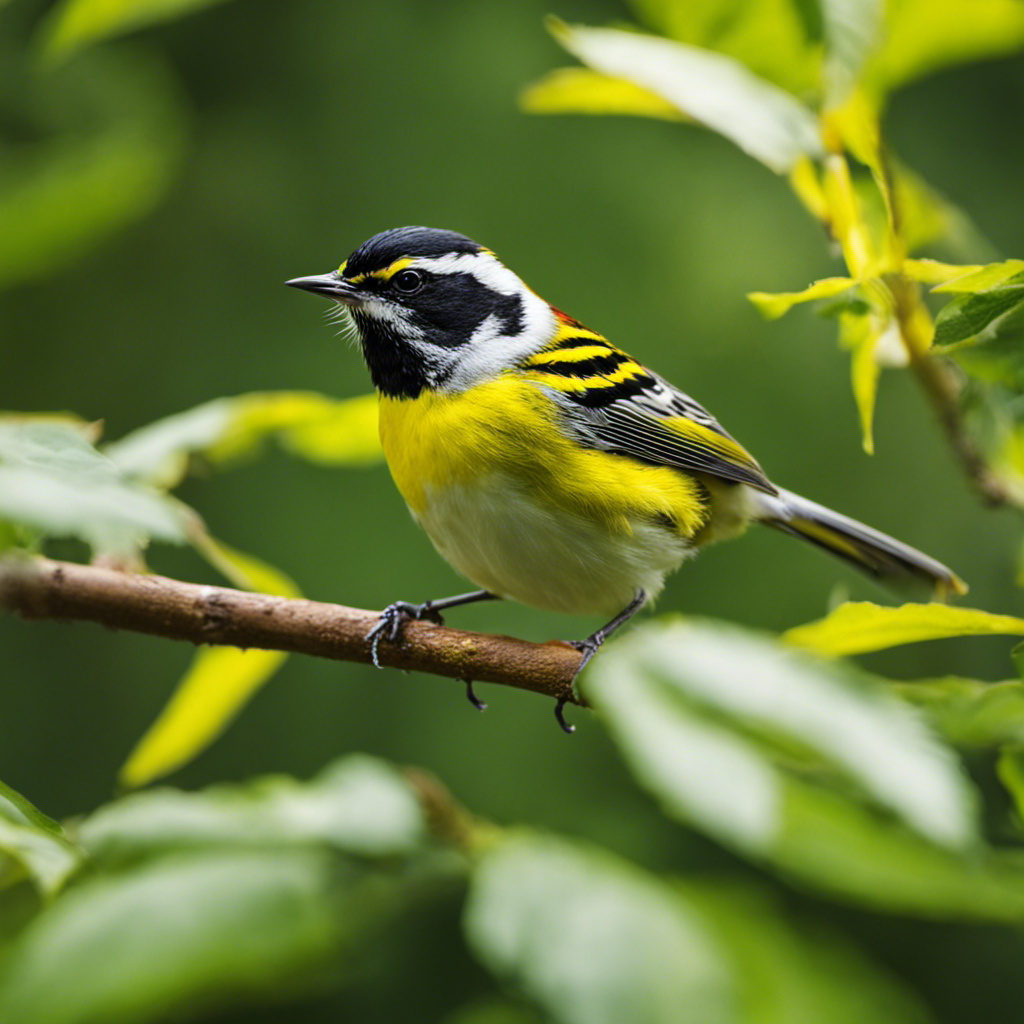
During the breeding season, listen closely for the distinct high-pitched song and look for the vibrant chestnut sides of the Chestnut-sided Warbler. This small songbird, scientifically known as Setophaga pensylvanica, is a migratory bird that breeds in eastern North America, including parts of Ohio. The Chestnut-sided Warbler is known for its striking appearance, with bright yellow plumage on its head and back, and chestnut-colored patches on its sides.
To understand the migration patterns and breeding habits of the Chestnut-sided Warbler, let’s take a look at the table below:
| Migration Patterns | Breeding Habits |
|---|---|
| Migratory | Monogamous |
| Flies to Central and South America during winter | Builds cup-shaped nests in shrubs or low trees |
| Migrates in flocks | Lays 4-5 eggs per clutch |
| Travels at night to avoid predators | Both parents participate in incubation and feeding |
Magnolia Warbler
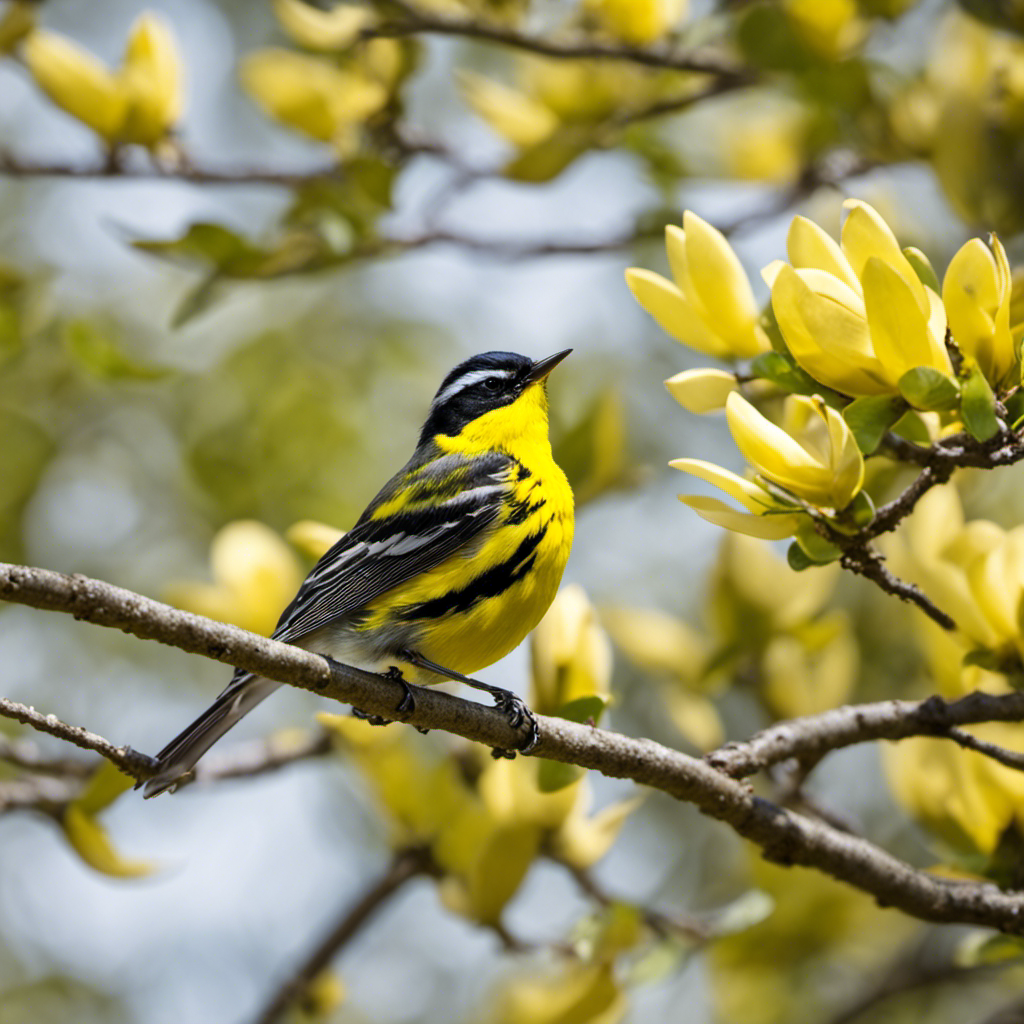
Listen closely for the distinct high-pitched song and look for the vibrant yellow plumage of the Magnolia Warbler, as it migrates through Ohio during the spring. This small songbird, scientifically known as Setophaga magnolia, is a fascinating species to observe.
Here are three key points about the magnolia warbler’s migration patterns and breeding habits:
Migration Patterns:
- The magnolia warbler is a long-distance migrant, traveling from its wintering grounds in Central America and the Caribbean to its breeding grounds in North America.
- During the spring migration, these birds pass through Ohio, making it an excellent location for birdwatchers to spot them.
- They typically arrive in Ohio in late April or early May and stay for a short period before continuing their journey northward.
Breeding Habits:
- Magnolia warblers prefer to nest in the boreal forests of Canada and Alaska.
- Their nests are usually built in shrubs or low trees, using grass, bark, and other plant materials for construction.
- These birds lay an average of 4-5 eggs, and both the male and female take turns incubating them for about 11-12 days.
Understanding the magnolia warbler’s migration patterns and breeding habits provides valuable insights into the behavior and ecology of this beautiful species.
Yellow-billed Cuckoo

You can spot up to nine yellow-billed cuckoos in Ohio during the summer months. These birds, known for their distinctive yellow bills, are migratory and breed in the eastern United States, including Ohio.
Yellow-billed cuckoos prefer riparian habitats, which are areas near rivers and streams with dense vegetation. They rely on these habitats for nesting and foraging, as they primarily feed on insects, especially caterpillars.
In terms of migration patterns, yellow-billed cuckoos spend their winters in South America and migrate to their breeding grounds in the eastern US during the spring. They typically arrive in Ohio in late April or early May and begin their return migration in late summer or early fall.
Understanding the yellow-billed cuckoo habitat and migration patterns is crucial for conservation efforts to ensure their continued presence in Ohio.
Eastern Meadowlark
If you walk along the grassy fields and listen carefully, you may catch a glimpse of the Eastern Meadowlark perched on a fence post. This beautiful bird is known for its vibrant yellow plumage and distinctive song.
Here are some key facts about the Eastern Meadowlark’s habitat, diet, mating, and nesting behavior:
Habitat and Diet:
- Eastern Meadowlarks can be found in open grasslands, pastures, and meadows throughout North America.
- They prefer areas with tall grasses and scattered shrubs, as it provides cover and nesting sites.
- Their diet consists mainly of insects, spiders, beetles, grasshoppers, and seeds.
Mating Behavior:
- Male Eastern Meadowlarks defend their territories by singing from prominent perches to attract females.
- They perform elaborate flight displays, including soaring and fluttering, to court potential mates.
- Once a pair forms, they build a cup-shaped nest on the ground, usually hidden in grasses or shrubs.
Nesting Behavior:
- The female Eastern Meadowlark lays 3-7 eggs, which she incubates for about two weeks.
- Both parents participate in feeding and caring for the young after they hatch.
- The nestlings fledge after 9-12 days and become independent shortly after.
Understanding the Eastern Meadowlark’s habitat, diet, mating, and nesting behavior provides valuable insight into the life of this remarkable bird.
Baltimore Oriole
Sure, now let’s move on to the Baltimore Oriole, a vibrant bird that’s known for its brilliant orange and black plumage.
The Baltimore Oriole is a migratory bird that spends its winters in Central and South America and returns to North America during the spring. Their migration patterns are influenced by changes in temperature and food availability.
During the breeding season, Baltimore Orioles exhibit interesting nesting behavior. The male builds a pendulous nest made of plant fibers, grasses, and even string or yarn, usually hanging from the tips of tree branches. The female then lays her eggs, typically 3-7 in number, and both parents take turns incubating them.
After the eggs hatch, the parents work together to feed and care for the nestlings until they’re ready to fledge.
Orchard Oriole
Now that we’ve discussed the Baltimore Oriole, let’s move on to the Orchard Oriole, which is another beautiful yellow bird commonly found in Ohio.
The Orchard Oriole (Icterus spurius) is a small passerine bird that belongs to the blackbird family. It’s primarily known for its vibrant yellow plumage with contrasting black wings and tail.
Here are three key points about the Orchard Oriole and its bird migration patterns:
Breeding Grounds: Orchard Orioles breed across a wide range of eastern North America, including Ohio. They prefer habitats such as open woodlands, orchards, and edges of forests.
Wintering Grounds: During winter, Orchard Orioles migrate to Central America, particularly Mexico and parts of Central America. They’re neotropical migrants, meaning they travel long distances to spend the colder months in warmer climates.
Timing of Migration: Orchard Orioles typically arrive in Ohio for breeding season in late April or early May. They spend the summer months nesting and raising their young before embarking on their long journey south in September.
Understanding the bird migration patterns of the Orchard Oriole helps us appreciate their incredible journeys and the importance of preserving their habitats along their migratory routes.
Yellow-headed Blackbird
You should check out the Yellow-headed Blackbird, as it’s another fascinating yellow bird that can be found in certain parts of Ohio.
The Yellow-headed Blackbird (Xanthocephalus xanthocephalus) is a unique species found in wetland habitats throughout the state. These birds are known for their vibrant yellow head and black body, making them easily distinguishable in the field.
However, the Yellow-headed Blackbird population in Ohio has been declining due to habitat loss and degradation. To address this issue, habitat conservation efforts are being implemented to protect and restore wetland areas.
Birdwatching and citizen science play a crucial role in monitoring the population of Yellow-headed Blackbirds. By participating in bird counts and reporting sightings, birdwatchers contribute valuable data that helps scientists track the health and status of these birds.
Overall, understanding and conserving these unique yellow birds are essential to maintaining biodiversity in Ohio’s ecosystems.
Western Meadowlark
If you spot a Western Meadowlark in Ohio, it’s a special sighting since they aren’t commonly found in this region. The Western Meadowlark is a beautiful bird with vibrant yellow plumage and a distinctive black V-shaped mark on its chest. Here are three key points to understand about this species:
Habitat: Western Meadowlarks prefer open grasslands and prairies with short grasses, as they rely on these areas for nesting and foraging. They’re seldom found in densely forested areas.
Migration patterns: Western Meadowlarks are known for their long-distance migration. During the breeding season, they can be found in the western and central parts of North America. However, in winter, they migrate southwards to Mexico and even as far as Central America.
Vocalizations and mating behaviors: The Western Meadowlark is famous for its melodious song, which consists of a series of flute-like notes. Males use their vocalizations to defend their territories and attract mates. They also engage in elaborate courtship displays, such as aerial displays and ground displays, to impress females.
Yellow-bellied Sapsucker
You may occasionally spot a Yellow-bellied Sapsucker in Ohio, for they’re known to migrate through the region during certain times of the year.
The Yellow-bellied Sapsucker is an interesting woodpecker species in Ohio that has a significant impact on local tree health and ecology. This species is named for its distinctive yellow belly and its habit of drilling rows of small holes in tree trunks.
These holes serve as sap wells, from which the sapsucker feeds on the sap and any insects that become trapped in it. While this feeding behavior can cause damage to the trees, it also provides an important food source for other wildlife, such as hummingbirds and insects.
Additionally, the sapsucker’s drilling activities create cavities that are used by other bird species for nesting. Thus, the Yellow-bellied Sapsucker plays a crucial role in the ecosystem of Ohio by both impacting tree health and providing resources for other organisms.
Are Yellow Birds and Green Birds Often Found in the Same Areas of Ohio?
Yes, common green birds Ohio are often found in the same areas as yellow birds. The varied habitat in Ohio provides a perfect environment for both species to coexist. From woodlands to grasslands, these colorful birds can be spotted throughout the state.
Frequently Asked Questions
What Is the Average Lifespan of a Yellow Warbler?
The average lifespan of a yellow warbler is around 2-3 years. They are known for their breeding behavior, building intricate nests and raising young. They also migrate long distances, often traveling from North America to South America.
How Can I Attract American Goldfinches to My Backyard?
To attract American goldfinches to your backyard, create a bird-friendly environment. Provide a variety of native plants, especially those that produce seeds. Offer a reliable water source, such as a birdbath, and avoid using pesticides.
What Is the Preferred Nesting Habitat of the Prothonotary Warbler?
To attract prothonotary warblers to your backyard, provide preferred nesting sites near water such as swamps, marshes, or wetland edges. These yellow birds prefer to breed in natural cavities or nest boxes close to water sources.
Do Yellow-Throated Warblers Migrate During the Winter?
Do yellow-throated warblers migrate during the winter? Yes, they do migrate to Florida. Their diet consists mainly of insects, spiders, and occasionally berries. Migration allows them to find suitable food and habitat.
How Can I Distinguish Between the Songs of the Chestnut-Sided Warbler and the Magnolia Warbler?
To distinguish between the songs of the Chestnut-sided Warbler and the Magnolia Warbler, listen for distinctive features such as rhythm, pitch, and pattern. The Chestnut-sided Warbler has a buzzy and repetitive song, while the Magnolia Warbler’s song is more musical and trill-like.
Conclusion
In conclusion, Ohio is home to a variety of yellow birds, including the American Goldfinch, Yellow Warbler, Common Yellowthroat, Hooded Warbler, Kentucky Warbler, Orchard Oriole, Yellow-headed Blackbird, Western Meadowlark, and Yellow-bellied Sapsucker.
These vibrant species contribute to the diverse avian population in the state. Studying these birds can provide valuable insights into their behavior, migration patterns, and environmental impact.
Ohio’s yellow birds are a fascinating subject for scientific research and offer a visual delight for bird enthusiasts.

An avid ornithologist, zoologist and biologist with an unwavering passion for birds and wild animals.
Dr. Wilson’s journey in ornithology began in childhood and led him to obtain a Ph.D. in Ornithology from the prestigious Avian Research Institute. He has worked closely with renowned experts in the field and conducted extensive research and field studies globally.

